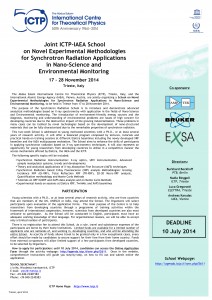JOINT ICTP-IAEA SCHOOL ON NOVEL EXPERIMENTAL METHODOLOGIES FOR SYNCHROTRON RADIATION APPLICATIONS IN NANO-SCIENCE AND ENVIRONMENTAL MONITORING supported by EXSA
Wednesday, April 16th, 2014PURPOSES AND TOPICS:
The Abdus Salam International Centre for Theoretical Physics (ICTP), Trieste, Italy, and the International Atomic Energy Agency (IAEA), Vienna, Austria, are jointly organizing a School on Novel Experimental Methodologies for Synchrotron Radiation Applications in Nano-Science and Environmental Monitoring, to be held in Trieste from 17 to 28 November 2014.
The purpose of the Synchrotron Radiation School is to introduce and demonstrate advanced analytical methodologies based on X-ray spectrometry with application in the fields of Nano-Science and Environmental monitoring. The introduction of environment-friendly energy sources and the diagnosis, monitoring and understanding of environmental problems are issues of high concern for developing countries due to the destructive impact of the growing industrialization. These problems in many cases can be tackled by novel technologies based on the development of nano-structured materials that can be fully characterized due to the remarkable properties of synchrotron radiation.
This two-week School is addressed to young motivated scientists with a Ph.D., or at least several years of research activity. It will offer a balanced program composed by lectures, tutorials and practical hands-on training sessions at different Elettra beamlines including the newly developed XRF beamline and the IAEA multipurpose endstation. The School aims to enhance the skills of participants in applying synchrotron radiation based on X-ray spectrometry techniques. It will also represent an opportunity for young researchers from developing countries to utilize in a competitive manner the access mechanisms offered by Elettra, the IAEA and the ICTP.
The following specific topics will be included:
- Synchrotron Radiation Instrumentation: X-ray optics, UHV instrumentation, Advanced sample manipulator systems, trends and developments
- Theory and analytical applications of X-ray Absorption Fine Structure (XAFS) techniques
- Synchrotron Radiation based X-Ray Fluorescence (XRF) analysis Methodologies: Grazing Incidence XRF (GI-XRF), Total Reflection XRF (TR-XRF), 2D-3D Micro-XRF analysis, Quantification methodology and Monte Carlo Methods
- Tutorials on XRF/GIXRF and XAFS data analysis and on Monte Carlo Methods
- Experimental hands on sessions at Elettra XRF, TwinMic and XAFS beamlines
PARTICIPATION:
Young scientists with a Ph.D., or at least several years of research activity, who are from countries that are members of the UN, UNESCO or IAEA, may attend the School. The Organizers will select participants upon evaluation of the application forms. The main purpose of the Centre is to help researchers from developing countries through a programme of training activities within the framework of international cooperation, however, scientists from developed countries are also most welcome to participate. As the School will be conducted in English, participants must have an adequate working knowledge of that language. For organizational reasons, we will be able to accept only a limited number of participants.
There is no registration fee to attend this School. As a rule, travel and subsistence expenses of the participants are borne by their home institutions. Limited funds are available for a limited number of applicants who are nationals of, and working in, developing countries, and who will be attending the entire School. As scarcity of funds allows travel to be granted only in a few exceptional cases, every effort should be made by candidates to secure support for their fare from their home country. Funds from external co-sponsors will allow limited support of a few participants from developed countries, to be selected by Organizers.
How to apply for participation: until 10 July 2014, candidates can access the Online Application Form through below link: Online Application Form Once in the website, comprehensive instructions will guide you step-by-step, on how to fill out and submit online the application.
SCHOOL WEB PAGE: http://agenda.ictp.it/smr.php?2611
ICTP WEBPAGE: http://www.ictp.it
DIRECTORS:
Burkhard Beckhoff, PTB, Berlin
Nadia Binggeli, ICTP, Trieste
Luca Gregoratti, ELETTRA, Trieste
Andreas Karydas, IAEA, Vienna
SCHOOL SECRETARIAT:
c/o Ms. Nicoletta Ivanissevich, ICTP
E-mail: smr2611@ictp.it
Fax: +39-040-22407383
Phone: +39-040-2240383
